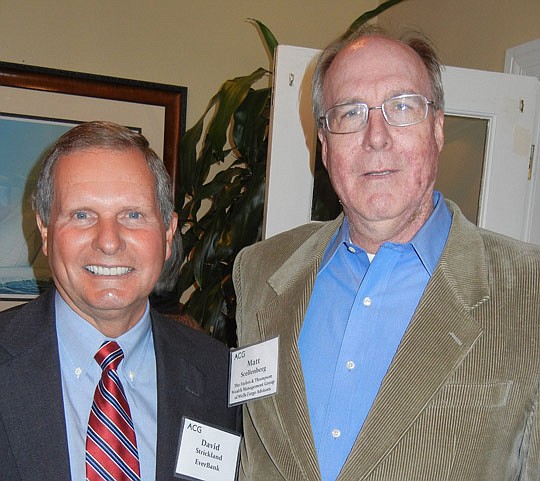
Three North Florida financial professionals agreed Thursday that the economy probably will remain generally on the same track for a while, but each had glimmers of good news.
JEA Managing Director and CEO Jim Dickenson, one of the panelists at the North Florida Association for Corporate Growth discussion, predicted that the area utility he leads will lower the cost of power this year.
“My prediction is we will lower the cost of electricity this year,” he told the almost 70 members and guests at the group’s annual “ACG’s Ten Ahead – Predictions for the Upcoming Decade.”
The group met at Epping Forest Yacht Club. Dickenson was joined by Northeast Florida Regional Council CEO Brian Teeple and Andres Gallo, department of economics and geography chair and associate professor at the University of North Florida Coggin College of Business.
Foley & Lardner Partner Michael Kirwan, president of the chapter, moderated the panel.
Dickenson said with more power generation from cheaper natural gas, costs fall. The JEA also might purchase into a nuclear power plant proposed by Duke Energy in South Carolina. Power plants are lessening their reliance on coal.
Dickenson, who announced this week he will retire from the organization in 2013 after 40 years of service, also said sewer rates will remain stable and water consumption per person continues to drop.
Among his predictions, he said that JEA will continue to diversify its fuel sources while also watching eight new Environmental Protection Agency regulations that could hit in two years, ranging from air emissions, to greenhouse gases, coal combustion byproducts and more.
Teeple, a planner, said the next 50 years will be bright, but he is “less bullish” on the next 10 years.
Teeple said that over the decade, the housing inventory will be absorbed and construction will be back “in full swing,” but at a “new normal.”
The number of jobs will increase and there will be land-use changes from residential holdings to non-residential, especially industrial uses.
On the bad news side, he predicts “environmental degradation” and expects “one or more events to make headlines,” such as algal blooms in the river. He predicts a “fight over water” sources; a weakened social safety net; the effects of an aging population; and widening income gaps.
Referring to the aging population and other issues, he said he was “not sure where all of this goes.” He sees the younger generation preparing.
“I think those in their mid-20s realize it’s time to roll up their sleeves and the world depends on them,” Teeple said.
Gallo outlined how economic indicators show why consumers and businesses don’t sense a strong recovery from the recession, and that’s because there hasn’t been one.
His presentation tracked gross domestic product, consumption, business investment, government expenditures, exports and imports for the 16 months since the start of the 2007-09 recession and compared their progress to the 16 months following the start of the previous four recessions.
For the most part, the economy has not recovered as quickly or strongly this time. Consumer consumption, for example, is “barely the same as what it was before the recession,” he said.
Consumption is up just 1 percent; investment is down; exports are up; imports are up very slightly; and government spending is up just 2 percent.
“We need to put our house in order,” he said.
356-2466